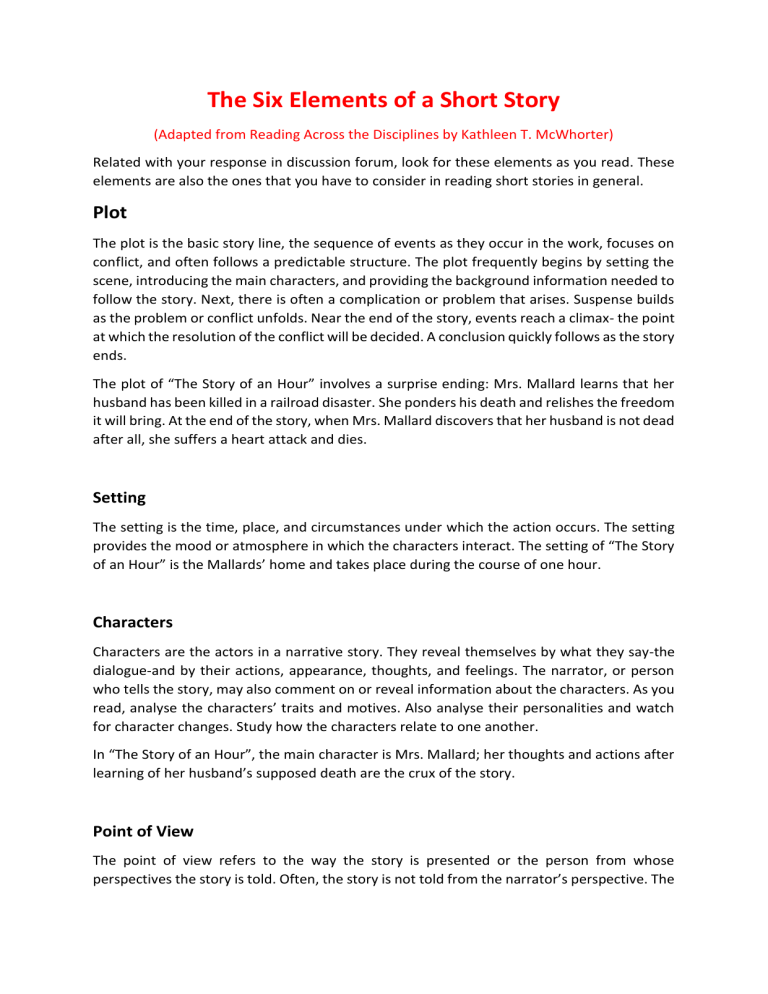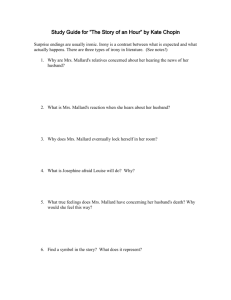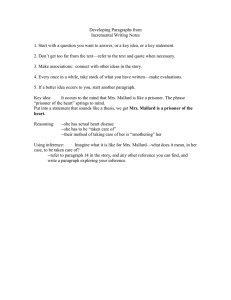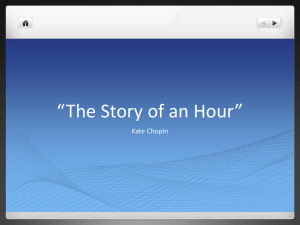
The Six Elements of a Short Story (Adapted from Reading Across the Disciplines by Kathleen T. McWhorter) Related with your response in discussion forum, look for these elements as you read. These elements are also the ones that you have to consider in reading short stories in general. Plot The plot is the basic story line, the sequence of events as they occur in the work, focuses on conflict, and often follows a predictable structure. The plot frequently begins by setting the scene, introducing the main characters, and providing the background information needed to follow the story. Next, there is often a complication or problem that arises. Suspense builds as the problem or conflict unfolds. Near the end of the story, events reach a climax- the point at which the resolution of the conflict will be decided. A conclusion quickly follows as the story ends. The plot of “The Story of an Hour” involves a surprise ending: Mrs. Mallard learns that her husband has been killed in a railroad disaster. She ponders his death and relishes the freedom it will bring. At the end of the story, when Mrs. Mallard discovers that her husband is not dead after all, she suffers a heart attack and dies. Setting The setting is the time, place, and circumstances under which the action occurs. The setting provides the mood or atmosphere in which the characters interact. The setting of “The Story of an Hour” is the Mallards’ home and takes place during the course of one hour. Characters Characters are the actors in a narrative story. They reveal themselves by what they say-the dialogue-and by their actions, appearance, thoughts, and feelings. The narrator, or person who tells the story, may also comment on or reveal information about the characters. As you read, analyse the characters’ traits and motives. Also analyse their personalities and watch for character changes. Study how the characters relate to one another. In “The Story of an Hour”, the main character is Mrs. Mallard; her thoughts and actions after learning of her husband’s supposed death are the crux of the story. Point of View The point of view refers to the way the story is presented or the person from whose perspectives the story is told. Often, the story is not told from the narrator’s perspective. The story may be told from the perspective of one of the characters, or that of an unknown narrator. “The Story of an Hour” is told by a third-person narrator who is knowledgeable and understand the characters’ actions and motives but is not part of the action. In the story’s last line, the narrator tells us that doctors assumed Mrs. Mallard died of “joy that kills.” Tone The tone or mood of a story reflects the author’s attitude. Tone suggests feelings. The author’s feelings are not necessarily those of the characters or narrator. Instead, it is through the narrator’s description of the characters and their actions that we infer tone. In the “Story of an Hour”, the tone might be described as serious. Serious events occur that dramatically affect Mrs. Mallard’s life. The story also has an element of surprise and irony. We are surprised to learn that Mr. Mallard is not dead after all, and it is ironic, or the opposite of what we expect, to learn than Mrs. Mallard dies “of joy that kills.” Theme The theme of the story is its meaning or message-its main idea or main point. Themes are often large, universal ideas dealing with life and death, human values, or existence. To establish the theme, ask yourself, “What is the author trying to say about life by telling the story. One theme of “The Story of an Hour” is freedom. Mrs.Mallard experiences a sense of freedom upon learning of her husband’s supposed death. She sees “a long procession of years to come that would belong to her absolutely.” There is also a theme of rebirth, suggested by references to springtime; her life without her husband was just beginning. The author also may be commenting on the restrictive or repressive nature of marriage during the time the story was written. After Mr. Mallard’s death, “There would be no powerful will bending hers…” Mrs. Mallard, after all, dies not from losing her husband but from the thought of losing her newly found freedom. If you are having difficulty stating the theme, try the following suggestions: 1. Study the title. Now that you have read the story, does it take on any new meanings? 2. Analyze the main characters. Do they change? If so, how and in reaction to what? 3. Look for broad general statements. What do the characters, or the narrator say about life or the problems they face? 4. Look for symbols, figurative expressions, meaningful names (example: Mrs. Good-hear), or objects that hint at larger ideas.



